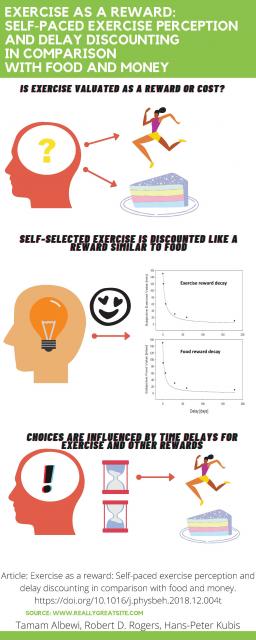Do you value exercise?
By Tamam Albelwi, Robert D. Rogers, Hans-Peter Kubis
Exercise has many health benefits but, surprisingly, only a small minority is really physically active to an appropriate level.
Why this is the case, is under discussion for a long time and several theories have been developed. However, researchers have not investigated how people evaluate exercise if it comes to decision making and whether people process exercise like a reward (i.e. food or money), or rather like a cost.
One interesting fact for the evaluation of rewards is, that we subconsciously do not give rewards a stable value over time. Waiting for a reward declines its subjective value; this is called time discounting. People make choices subconsciously using the decline in subjective value and the size of values to support decision making.
Our article is the first, to investigate how people evaluate exercise (here – self-paced walking and running) during decision making. We optimized the exercise based on peoples’ feelings in several trials and later investigated how the subjective value declines over time in comparison with food and money rewards.
The outcomes, investigating healthy young people, show that exercise is evaluated as a reward and very similar to food rewards; the decline of value in time is faster than of money. This makes problems in decision making if exercise (like going to the gym) is connected with time delays (transport, changing etc.), while alternative choices with similar value are close by; people will likely decide not for the exercise.
Measured exercise motivation and physical activity showed that people who integrated more delayed goals (e.g. fitness, looks, strength) into exercise revealed slower decay in their valuation of exercise; people with high exercise motivation might still go to the gym even if the food is on the table.
The article is important because it shows that exercise is processed as a reward and suggests that exercise participation might be impaired due to time delays (i.e. accessibility and transport - due to disappearing playgrounds and green belts, unsafe city areas, reduced numbers of public footpaths etc.).
 Exercise as a reward
Exercise as a reward
Publication date: 23 July 2020
